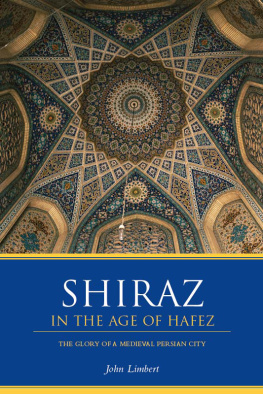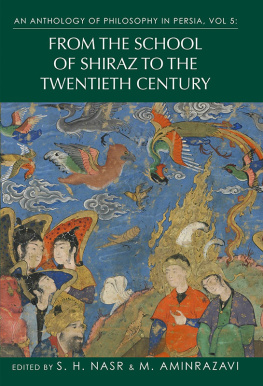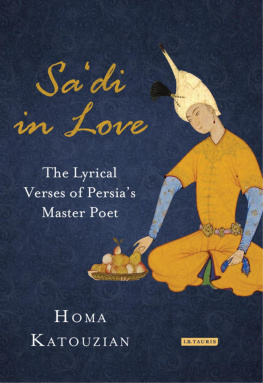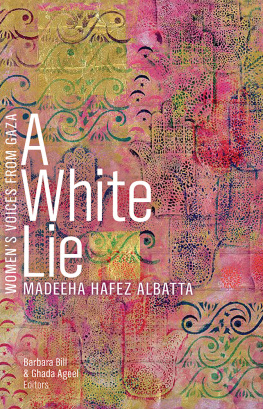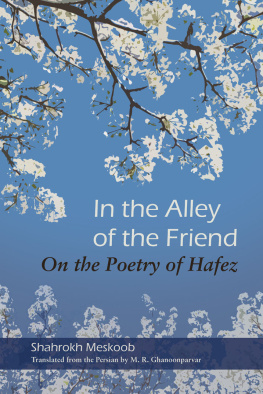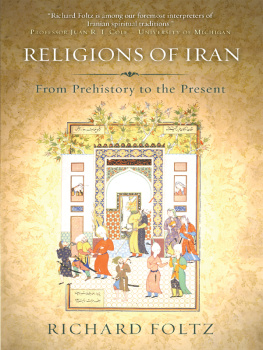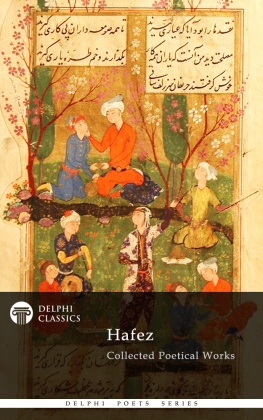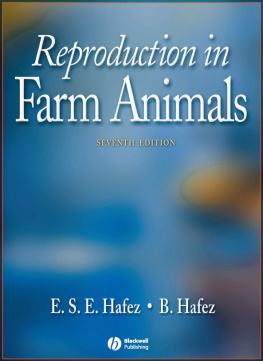APPENDIX
THE FIRST FAMILIES OF SHIRAZ
An important feature of Shirazi society was the continuity and stability of its leading families. In other regions of Iran the destruction and turmoil that accompanied the Mongol invasions of the thirteenth centuryand their chaotic aftermathwiped out many ancient aristocratic families. In Shiraz, however, most of the leading families preserved their wealth and influence through the thirteenth and fourteenth centuries despite recurrent, violent political changes. Such social stability in a violent age testifies both to the adaptability of the Shirazi aristocrats (who could retain their influence through frequent changes of ruler) and to the foresight of the rulers themselves, who, whatever their faults, could see the benefit of keeping the local aristocracy and social structure intact.
The genealogies in this section reveal both the continuity of the leading Shirazi families and the network of their relationships, at least among the men of these families. The sources provide very little information about the female side, saying only, He married a daughter of so-and-so, or He studied with so-and-so, his maternal uncle. Female names occur only in those rare instances where the woman herself ranked among the saints or scholars. Even among the males, the available sources do not always spell out exact family relationships.
The genealogies of three aristocratic clans, each representing a different kind of noble family in fourteenth century Shiraz, are worth considering in detail. The Baghnovis were most famous as preachers and sufi masters, with an extensive, well-documented network of marriage relationships with other aristocratic families of Shiraz. The Fali-Sirafis were best known as teachers and judges, who held a position so lofty that they did not marry into the local nobility. The Alavi-Mohammadis were prestigious local seyyeds, who intermarried mostly with other families of Alavis.
THE BAGHNOVIS
Because this was the family of the author of Shadd al-Izar, we have extensive information about its members. This family claimed Arab origins and traced its ancestry to the Qoreish tribe and to Omar, the second caliph. It held charters from the Omayyad caliph Omar b. Abd al-Aziz and from the Buyid ruler Azod al-Dowleh. Originally landowners in Fasa, the first of the family to settle in Shiraz was Sheikh Zein al-Din Mozaffar b. Ruzbehan b. Taher, who made his home there during the second half of the twelfth century. Sheikh Mozaffar was most famous as a preacher in the Old Congregational Mosque and in the rabat of Sheikh Abu Zare Ardabili, and as a teacher in the Bagh-e-Now mosque. He associated with the Salghurid Atabek Tekleh b. Mowdud (r. ca. 1175-95) and in his preaching used to tell the rulers, O Turks, do this and refrain from that! Although Sheikh Zein al-Din Mozaffar resided in the Jame Atiq area, at his death in 1207 he was buried in the Bagh-e-Now district. It was from this association with the latter area that his descendants took their nesbat of Baghnovi.
The true patriarch of the Shiraz Baghnovis, however, was Sheikh Zein al-Din's grandson, Sheikh Sadr al-Din Abu Mo'ali Mozaffar b. Mohammad (d. 1289). Unlike his grandfather, who had traveled widely in Iraq, Arabia, India, and Syria, Sheikh Sadr al-Din spent most of his life in Shiraz, where he studied under the leading teachers of the time, including Qazi Majd al-Din Esma'il Fali, Qazi Jamal al-Din Mesri, Mowlana Emam al-Din Beiza'i, and the sufi leader Sheikh Mo'in al-Din Abdullah Kathki. The ruler, Atabek Abu Bakr, greatly respected him, and offered him his father's post of va'ez (preacher) of the Old Congregational Mosque. Sheikh Sadr al-Din, however, refused the appointment, preferring to preach in the smaller, humbler mosque of Bagh-e-Now.
Sheikh Sadr al-Din Mozaffar was most famous as a scholar and a preacher. He also acquired sufi connections by marrying a descendant of the Sheikh al-Shoyukh, Abu al-Hosein Ahmad b. Salbeh Beiza'i (d. 1023),
Sheikh Sadr al-Din Mozaffar had seven sons, all of whom became scholars, and many daughters, who married into important Shirazi families. One of his daughters married Sheikh Shahab al-Din Abu al-Kheir Zarkub, the father of Mo'in al-Din Ahmad, the author of the Shiraznameh. One of Sheikh Mo'in al-Din's first teachers was his mother's brother, Sheikh Haj Rokn al-Din Mansur Rastgu, a son of Sheikh Sadr al-Din Mozaffar. Another daughter married into the family of Kasa'i, about which little is known, except that they, like the Zarkubs, were associated with the Baghdadi mosque.
Sheikh Sadr al-Din's eldest son, Sheikh Sa'd al-Din As'ad, died young (1271), before his father. Sheikh Sa'd al-Din's great-grandson was Sheikh Mo'in al-Din Joneid (d. ca. 800/1398), the poet and author of Shadd alIzar. Two of Sheikh Sadr al-Din's sons, Zein al-Din Taher and Rokn al-Din Mansur, married into the families of their father's fellow students: the former married a granddaughter of Faqih Sa'en al-Din Hosein Salmani, author of Tarikh-e-Mashayekh-e-Fars; the latter (and more famous son) married a daughter of Amir Asil al-Din Alavi-Mohammadi.
In addition to their fame as sheikhs and scholars, the Baghnovi family members were always associated with Shiraz's Old Congregational Mosque. Although Sheikh Sadr al-Din had refused to accept the Atabek's invitation to preach there, both his son Haj Rokn al-Din Mansur and his grandson Rokn al-Din Yahya b. Mansur held the post of va'ez in that mosque. Shah Sheikh Abu Eshaq also appointed the latter khatib (reader of the main Friday address) of that great mosque.
THE FALI-SIRAFIS
Although there are many biographies of this family of Shafe'i judges, we know less about them than we do about the Baghnovis and their associates. Information is sketchier because the sources do not record the marriage ties of the Fali-Sirafis, and the family members exalted rank as chief judges of Fars kept them above forming marriage alliances with local aristocratic families such as Baghnovi, Ruzbehan, or Zarkub. Judging by their titles of mowlana and qazi, the Fali-Sirafis were better know as judges and teachers, and presumably less involved in sufism and preaching.
The first member of the family of whom we know more than a name is Qazi Saraj al-Din Abu al-Ezz Mokarram b. Ala Fali (d. 1224), who was chief judge of Fars and khatib of the New Mosque (Masjed-e-Now) in Shiraz.
Named after his grandfather, Qazi Rokn al-Din's son, Qazi Majd al-Din Esma'il (1271-1355) was chief judge of Fars under the Injus and the most famous figure of the Fali-Sirafi family. Hafez eulogized him in his poems, and Ibn Battuta reported how the rulers, nobles, and ordinary citizens of Shiraz held him in great respect. When Qazi Majd al-Din became nearly blind in his old age, his nephews, Ala al-Din and Majd al-Din, took care of legal matters for him. With the death of Qazi Majd al-Din in 1355, the chief judgeship of Fars passed out of the family of Fali-Sirafi. Although the family continued to be important (there were still eminent Falis in Shiraz in 1972), under the Mozaffarids it lost the lofty position it had occupied under the Salghurids, Mongols, and Injus.
The sources contain biographies of other members of this family whose relationships to the three chief judges are not clear. The fact that all of the Fali-Sirafis held the title mowlana indicates that they were most famous as teachers. One collateral branch of this family included Mowlana Qotb al-Din Mohammad b. Abu al-Kheir Fali (d. 712 or 721/1312 or 1321), who composed a famous commentary (sharh) on the work of his ancestor, the Salghurid minister Amid al-Din Vazir Afzari.
THE ALAVI-MOHAMMADIS
As their genealogy shows, in the thirteenth and fourteenth centuries the Alavi-Mohammadis were less a family than a series of alliances through the female side, all related to a single figureAmir Asil al-Din Abdullah (d. 1286 or 1291). Since the Shirazis usually traced family descent through the male line, strictly speaking the Alavi-Mohammadi family ended with the death of Amir Asil al-Din's son, Naser al-Din Yahya b. Abdullah, in the early fourteenth century. Amir Asil-al-Din, however, was such a towering figure that the biographers of his sister's and daughters children placed great emphasis on their maternal descent, and considered them members of an extended Alavi-Mohammadi family.

